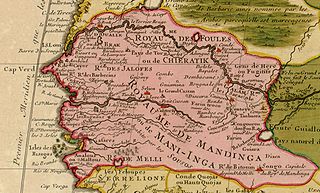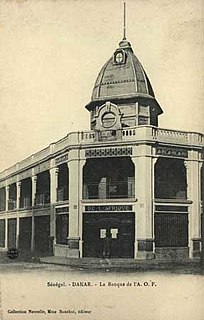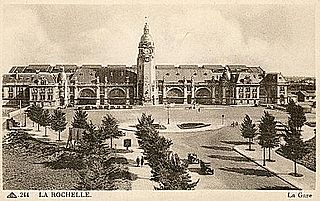
The history of Senegal is commonly divided into a number of periods, encompassing the prehistoric era, the precolonial period, colonialism, and the contemporary era.

French West Africa was a federation of eight French colonial territories in Africa: Mauritania, Senegal, French Sudan, French Guinea, Ivory Coast, Upper Volta, Dahomey and Niger. The federation existed from 1895 until 1958. Its capital was Saint-Louis, Senegal until 1902, and then Dakar until the federation's collapse in 1960.

The Mississippi Company was a corporation holding a business monopoly in French colonies in North America and the West Indies. In 1717, the Mississippi Company received a royal grant with exclusive trading rights for 25 years. The rise and fall of the company is connected with the activities of the Scottish financier and economist John Law who was then the Controller General of Finances of France. When the speculation in French financial circles, and the land development in the region became frenzied and detached from economic reality, the Mississippi bubble became one of the earliest examples of an economic bubble.

Banque d'Afrique Occidentale : was a bank French colonial authorities established in 1901 in Dakar, Sénégal, as the central bank of the colonies of French West Africa.

The Chemins de fer de l'État, often referred to in France as the Réseau de l'État, was an early state-owned French railway company.

The Ostend Company, officially the General Company Established in the Austrian Netherlands for Commerce and Navigation in the Indies was a chartered trading company in the Austrian Netherlands in the Holy Roman Empire which was established in 1722 to trade with the East and West Indies. It took its name from the Flemish port city of Ostend.
A chartered company is an association with investors or shareholders that is incorporated and granted rights by royal charter for the purpose of trade, exploration, and/or colonization.
The Company of the American Islands was a French chartered company that in 1635 took over the administration of the French portion Saint-Christophe island from Compagnie de Saint-Christophe which was the only French settlement in the Caribbean at that time, and was mandated to actively colonise other islands. The islands settled for France under the direction of the Compagnie des Îles de l'Amérique before it was dissolved in 1651 were:
The French West India Company was a French trading company founded on 28 May 1664, some 3 months before the foundation of its eastern company, by Jean-Baptiste Colbert and dissolved on 2 January 1674. The company received the French possessions of the Atlantic coasts of Africa and America, and was granted a monopoly on trade with America, which was to last for forty years. It was supposed to populate Canada, using the profits of the sugar economy that began in Guadeloupe. Its capital was six million pounds and its headquarters was in Le Havre.
Maba Diakhou Bâ, also known as Ma Ba Diakhu, Ma Ba Diakho Ba, Ma Ba Jaaxu, Mabba Jaxu Ba, was a Muslim leader in West Africa during the 19th century. Born in Rip, Maba was a disciple of the Tijaniyya Sufi brotherhood and became the Almami of Saloum.
The French conquest of Senegal started in 1659 with the establishment of Saint-Louis, Senegal, followed by the French capture of the island of Gorée from the Dutch in 1677, but would only become a full-scale campaign in the 19th century.

François d'Aubusson de La Feuillade, known as 6th duc de Roannais (1631–1691) was a French military officer and noble who served in the wars of Louis XIV and became a Marshal of France. He was also responsible for initiating the design and construction of the Place des Victoires, one of modern Paris' most famous landmarks.
This is a timeline of the history and development of Serer religion and the Serer people of Senegal, The Gambia and Mauritania. This timeline merely gives an overview of their history, consisting of calibrated archaeological discoveries in Serer countries, Serer religion, politics, royalty, etc. Dates are given according to the Common Era. For a background to these events, see Roog, Serer religion, Serer creation myth, Serer prehistory, Lamane, States headed by Serer Lamanes, Serer history and Serer people.
The Royal House of Boureh Gnilane Joof was a royal house founded in the 14th century by Jaraff Boureh Gnilane Joof. He was a member the Serer tribe, from the pre-colonial Kingdom of Sine now part of independent Senegal. It was the first royal house founded by the Joof family during the Guelowar period. Boureh Gnilane Joof was a royal prince and a Jaraff, a Serer title of nobility with the powers of a Prime Minister. He was neither a Maad a Sinig nor a Maad Saloum but a royal prince who had the title Jaraff bestowed upon him by his cousin and brother-in-law - Maad a Sinig Diessanou Faye. His father Maad Patar Kholleh Joof was the king of Laa and Teigne of Baol. Boureh's brothers were the first from this house to have succeeded to the throne of Sine during the Guelowar period. His name was adopted in his honour to refer to the first royal house founded by the Joof family during this dynastic period. The Joof family of Sine, from this royal house also ruled in the Kingdom of Saloum The Joof family also ruled in Baol. From the date of its foundation up to the abolition of the Serer monarchies of Sine and Saloum in 1969, at least ten kings from this house had succeeded to the throne of Sine. As the first royal house of Sine founded by the Joof family in this dynastic period, the Royal House of Boureh Gnilane Joof holds great significance in Senegambian, Joof family and Serer history, because all the subsequent royal houses founded by the Joof family branched out from this royal house.

Lingeer Fatim Beye Joos Fadiou was a 14th-century Serer princess and queen (Lingeer) from the Kingdom of Sine. She is the matriarch and early ancestor of the Joos Maternal Dynasty of Waalo. She is usually regarded by some sources as the founder of the Joos Maternal Dynasty. The pre-colonial Kingdoms of Sine and Waalo now lies within present-day Senegal. Her surname is Beye (English-Gambia) or Bèye (French-Senegal). Joos Fadiou is her maternal clan. In Serer, "Fa-tim" means "the maternal clan of..."
The Compagnie du Sénégal (SCOA), officially the Compagnie du Sénégal et de la Côte occidentale d'Afrique was a 19th-century colonial French company involved in the palm oil trade in Nigeria.
The Senegal Company may refer to:
The following is a timeline of the history of the city of Saint-Louis, Senegal.
Eranove is a French company active in the management of public services and in the production of electricity and drinking water in Africa. The company was formerly known as Finagestion.
Lingeer Ngoné Dièye was a Lingeer from the Kingdom of Saloum, and early ancestor of the Guedj maternal dynasty of Cayor and Baol. She was the wife of the 17th century Senegambian noble and Teigne Thié Yasin Demba Noudj Fall, and mother of the controversial Damel—Teigne Lat Soukabé Ngoné Fall who ruled as King of Cayor and Baol from 1697 to 1719 and became the first Guedj to rule in those kingdoms—after overthrowing the reigning maternal dynasty and installing his mother's matriclan. In usurping the throne, he committed fratricide by killing his paternal half-brother and took his throne. Ngoné Dièye was a Serer noble of the Dièye family of Saloum. In the Wolof Kingdom of Cayor, she became Queen when she married the King of Cayor, and later Queen Mother of Cayor and Baol when her son usurped the throne and unified Cayor and Baol. According to Cheikh Anta Diop, "The Guedj come from common people. They are distinguished by their adaptive ability and their military genius. The dynasty is named for the country of origin of the first founding Damel's mother. She was a commoner from the seacoast, who married the King; guedj meaning "sea" in Wolof. Her son, though he had no right to the throne, succeeded in being crowned, through his energy and mental agility."








